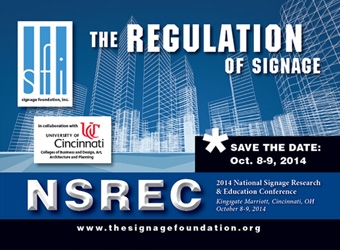The upcoming National Signage Research & Education Conference (NSREC) will devote several sessions to one of the most recurring issues affecting the on-premise sign industry: regulations.
NSREC, sponsored by The Signage Foundation, Inc., (SFI) and the University of Cincinnati (UC) Colleges of Business and Design, Art, Architecture and Planning (DAAP), will be October 8-9 at the Kingsgate Marriott in Cincinnati, Ohio.
Sessions scheduled include:
Guide for the Regulation of Temporary Signs, presented by Wendy Moeller, AICP, principal planner and owner of Compass Point Planning. Communities often struggle trying to find the right balance when considering regulations that apply to temporary signs, but fail to find any significant resources or materials on the topic that establish good practices for temporary-sign provisions. SFI sponsored research about temporary signs that was used to develop the Community Guide to Regulating Temporary Signs. This session will outline research, and main points and practices in the new guide that will serve as best-practices guides for communities nationwide.
The Economic Impact of Illuminated Signage: Results of a Survey of Users, presented by Charles R. Taylor, John A. Murphy Professor of Marketing and senior research fellow at the Center for Marketing and Public Policy Research at Villanova University. Taylor explored the impact of restricting illuminated signs on business success through a national survey of 750 sign owners. He found the ability to have an illuminated sign helped many businesses remain viable.
On-Premise Sign Research Review, presented by Philip Garvey, senior research associate, The Pennsylvania State University and Richard Crawford, legislative consultant, The United States Sign Council. This session details research conducted at Penn State through the years, including the recently completed study on LED EMC Lighting Levels.
Viewing Signs Through the Eyes of the Beholders: Perceptual Evidence from the American Grocery Shopper Survey, presented by James J. Kellaris, James S. Womack/Gemini Chair of Signage and Visual Marketing, UC College of Business. Kellaris shares results from the four-year longitudinal BrandSpark/Better Homes and Gardens American Shopper Study. He updates previous research on how shoppers are influenced by signage. He also includes new research into shopper thoughts on sign regulations.
Economics, Behavior and On-Premise Signs, presented by Craig Berger, Chair of the Visual Presentation and Exhibition Design Program at the Fashion Institute of Technology in New York City. Berger shows the impact of design metrics on the effectiveness of modern on-premise signs. He reviews the relative merits of each design area and formulates strategies for both the design and integration of on-premise signs into an overall design approach.
Reassessing the Importance of Sign Law in the Planning Law Classroom, Alan C. Weinstein, Cleveland State University, Eric Strauss, Michigan State University, and Dawn Jourdan, University of Oklahoma. These three educators detail the mismatch between the importance accorded sign regulation in planning-law courses and the importance sign regulation has in planning practice at the local government level. They detail how they have integrated sign regulation into planning-law courses in graduate programs approved by the Association of Collegiate Schools of Planning.
New Tools for Looking at the Importance of Signage, presented by Professors Chris Auffrey and Henry Hildebrandt, UC. This session summarizes the results of a graduate seminar at DAAP at UC. Graduate students used 3M Corporation’s Visual Attention Service (VAS) visual computational modeling software to analyze on-premise signage within urban-street and suburban-road contexts.
Evaluating Stakeholder Perceptions of Form-Based and On-Premise Signage Codes in Streetscapes, presented by Pat Crawford, Ph.D., PLA, Associate Director of the School of Planning, Design and Construction (SPDC) and an Associate Professor of Landscape Architecture at Michigan State University. This study will examine the impact of traditional and form-based codes on two model streetscape transformations and should enable the development of improved or “next gen” model sign codes.
Registration for the conference is now open at the Signage Foundation Web site http://www.thesignagefoundation.org with significant discounts until September 23.











